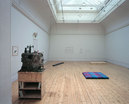Perpetual Motion Machine: The History Of The Industrial Revolution Explained By Way Of A Dyspeptic Metaphor, 2000
Perpetual Motion Machine: The History Of The Industrial Revolution Explained By Way Of A Dyspeptic Metaphor
Artworkers, a group exhibition that toured the UK in 2000. Curated by Melissa E. Feldman, with catalogue published by Oriel Mostyn Gallery and Newlyn Art Gallery.
This kinetic sculpture was built specifically for the exhibition and addressed the history of cultural exchange between The U.K. and its one time favorite colony, the U.S. The top part of the sculpture recalls a ruined Roman Colossus, atop which is situated a working model of a steam driven mine pump, which is the device often associated with the beginning of the Industrial Revolution. The side of the sculpture is decayed and hollowed out revealing a stone vault inside. The side of the vault is collapsed and reveals, of course, a large hamburger. This hamburger has a bite taken from it and a little Land Rover is sitting right in the resulting cavity. The diminutive vehicle is actually a phonograph cartridge and the bottom of the hamburger is a custom made aluminum record. Meanwhile, on the other side of the head, on the exterior, there sits among miniature rocks and trees a gigantic Gillette Mach 3 razor. Coming from the mouth of the Roman ruin is a wire which is strung through the museum and terminates in the gift shop, specifically on the total button operating the cash register drawer. Rounding out the parts of the sculpure are the following items: Two Coca Cola cans hang from the back of the head and the whole thing sits on top of a home made looking bookshelf. Fake solid wood books sit on the shelf, with titles like "The History of Plywood", "The History Of The Word 'Yeah' In Music", "Making Your Own Personal Hygiene Products", "Art Of The Past y", etc.
When an unsuspecting patron purchases something in the museum store, the sculputre springs to life. The mine pump starts to move, the razor glides up and down the side of the face, and the little Land Rover jumps into the hamburger. An audio commentary, describing various economic and social exchanges between the U.S. and U.K. is issued from the two Coke cans. This is followed by "Koka Kola" by The Clash, a song which compares advertising practices and drug abuse. At the end of the song, the record resets and the sculpture becomes inert again until another purchase is made. The technology for the Gillette Razor was developed in Sheffield, England, which has been famous for its high quality steel since the beginning of the Industrial Revolution. The mine pump and the razor are meant to bracket this period, with this disposable, almost useless tool, overburdened with extra blades designed to become dull at lightning speed representing the final stage of mass production. The interior of the head is activated by symbols of consumption, while its exterior is decayed and its history forgotten.
Projects
Steven Brower home
This kinetic sculpture was built specifically for the exhibition and addressed the history of cultural exchange between The U.K. and its one time favorite colony, the U.S. The top part of the sculpture recalls a ruined Roman Colossus, atop which is situated a working model of a steam driven mine pump, which is the device often associated with the beginning of the Industrial Revolution. The side of the sculpture is decayed and hollowed out revealing a stone vault inside. The side of the vault is collapsed and reveals, of course, a large hamburger. This hamburger has a bite taken from it and a little Land Rover is sitting right in the resulting cavity. The diminutive vehicle is actually a phonograph cartridge and the bottom of the hamburger is a custom made aluminum record. Meanwhile, on the other side of the head, on the exterior, there sits among miniature rocks and trees a gigantic Gillette Mach 3 razor. Coming from the mouth of the Roman ruin is a wire which is strung through the museum and terminates in the gift shop, specifically on the total button operating the cash register drawer. Rounding out the parts of the sculpure are the following items: Two Coca Cola cans hang from the back of the head and the whole thing sits on top of a home made looking bookshelf. Fake solid wood books sit on the shelf, with titles like "The History of Plywood", "The History Of The Word 'Yeah' In Music", "Making Your Own Personal Hygiene Products", "Art Of The Past y", etc.
When an unsuspecting patron purchases something in the museum store, the sculputre springs to life. The mine pump starts to move, the razor glides up and down the side of the face, and the little Land Rover jumps into the hamburger. An audio commentary, describing various economic and social exchanges between the U.S. and U.K. is issued from the two Coke cans. This is followed by "Koka Kola" by The Clash, a song which compares advertising practices and drug abuse. At the end of the song, the record resets and the sculpture becomes inert again until another purchase is made. The technology for the Gillette Razor was developed in Sheffield, England, which has been famous for its high quality steel since the beginning of the Industrial Revolution. The mine pump and the razor are meant to bracket this period, with this disposable, almost useless tool, overburdened with extra blades designed to become dull at lightning speed representing the final stage of mass production. The interior of the head is activated by symbols of consumption, while its exterior is decayed and its history forgotten.
Projects
Steven Brower home


